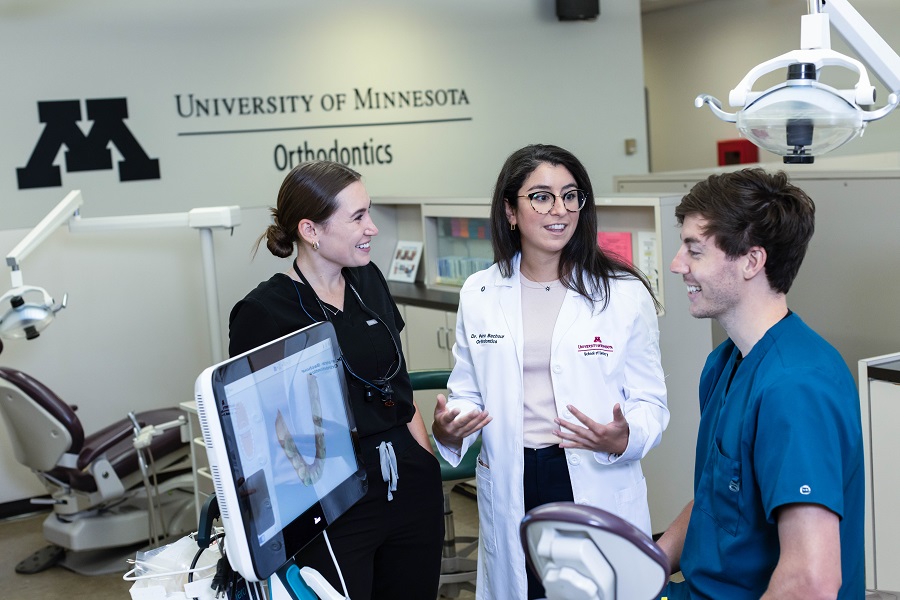
Straighter teeth and an improved smile are well-known benefits of orthodontics, but the benefits of orthodontic care are varied and critical for comprehensive health.
For National Orthodontic Health Month in October, Dr. Petra Bachour, a clinical assistant professor in the School of Dentistry, corrects common misconceptions about orthodontics and discusses why taking care of your orthodontic health is so important.
Q: What do orthodontists do? How is their work different from that of a general dentist?
Bachour: The field of orthodontics focuses on straightening teeth, correcting bite problems such as overbites and underbites, aligning jaws and achieving facial harmony. Orthodontists are experts in diagnosis, prevention and treatment of dental and facial irregularities.
All orthodontists are dentists, but not all dentists are orthodontists. Orthodontists undergo an additional two to three years of specialist training after dental school to become experts in craniofacial growth and development, proper tooth movement and orthodontic diagnosis and treatment planning.
Q: Why is it important to overall health to correct misaligned teeth and jaws?
Bachour: Aligning teeth and correcting the bite can have several benefits. Severely crowded or overlapped teeth can be difficult to clean. Aligning the teeth can facilitate good oral hygiene and improve gum health. Some patients have bite problems that prevent them from being able to chew properly or that can result in speech problems — correcting these problems can have a dramatic effect on function. In some cases, teeth do not develop or emerge properly and may get impacted (trapped) in the jaws or cause damage to other teeth. In patients where the teeth contact too heavily or irregularly in the front, wear and damage to the permanent teeth can result. Orthodontists can identify all of these situations and intervene appropriately.
In addition to all the functional and dental benefits of orthodontics, orthodontic treatment almost always results in an aesthetic improvement of the teeth and smile that can boost confidence and self-esteem.
Q: What tips do you have for people to take care of their orthodontic health?
Bachour: Start young! The American Association of Orthodontists (AAO) recommends that children have their first orthodontic examination by age 7, or earlier if you notice a problem. Not everyone will need orthodontic treatment at this time, but an initial examination is important to check growth and development of the teeth and jaws and identify and intercept developing or existing problems.
If you are interested in orthodontic treatment, it is never too late to see an orthodontist. Orthodontists treat patients of all ages. The number of adults in orthodontic treatment has increased over the years. Many aesthetic treatment options exist for adults, such as clear aligners and clear braces.
Lastly, if you have had orthodontic treatment in the past, make sure to wear your retainers as instructed by your orthodontist to best maintain your results. Teeth can shift throughout life, so retention is a lifelong process. If your teeth have shifted and you would like them straightened again, your orthodontist may be able to do a re-treatment to bring them back into position.
Q: Many people associate orthodontists with their experiences with braces many years ago. How have orthodontics changed in recent years?
Bachour: Orthodontics has seen tremendous changes in recent years. Technological advances in the field have ushered in an era of enhanced diagnostic precision, virtual treatment planning and treatment options customized for each person. For example, intraoral scanning and 3D-printed models have largely replaced the goopy impressions of the past. And while past treatment options were mostly limited to metal braces and a few bulky appliances, nowadays many treatment options exist. In addition to metal braces, clear aligners, clear braces and lingual braces are some of the options available today.
Q: What type of research and clinical work are you doing at the U of M to advance the field of orthodontics?
Bachour: My research and clinical interests lie in digitally-driven orthodontics. I believe that precision orthodontic care is the way of the future, and my research focuses on evaluating the efficacy and efficiency of emerging orthodontic technologies. As orthodontists, we have many new tools at our disposal for patient care. My research aims to critically evaluate these tools to provide doctors with information that they can directly translate to clinical care.
Petra Bachour, DMD, MS, is a clinical assistant professor in the Division of Orthodontics at the University of Minnesota School of Dentistry. Dr. Bachour joined the orthodontic faculty at the University of Minnesota in 2022. She continues to practice orthodontics in the community.
-30-
About the School of Dentistry
The University of Minnesota School of Dentistry advances health through scientific discovery, innovative education and the highest-quality care for all communities. As the state's only dental school, the School of Dentistry educates the next generation of oral health professionals and is a resource to five states for dental education and consultation. Of Minnesota’s practicing dentists, 72 percent are graduates of the dental school. Through its clinics, the School of Dentistry also sees more than 156,000 patient visits each year. Learn more at dentistry.umn.edu.
About “Talking...with U of M”
“Talking...with U of M” is a resource whereby University of Minnesota faculty answer questions on current and other topics of general interest. Feel free to republish this content. If you would like to schedule an interview with the faculty member or have topics you’d like the University of Minnesota to explore for future “Talking...with U of M,” please contact University Public Relations at [email protected].




